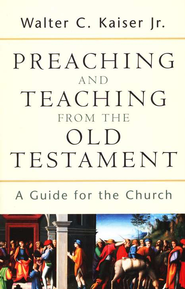Walter Kaiser: Preaching and Teaching from the Old Testament
 Walter C. Kaiser, Jr., Preaching and Teaching from the Old Testament: A Guide for the Church (Grand Rapids: Baker Academic, 2003), 222 pages, ISBN 9780801026102.
Walter C. Kaiser, Jr., Preaching and Teaching from the Old Testament: A Guide for the Church (Grand Rapids: Baker Academic, 2003), 222 pages, ISBN 9780801026102.
How do you preach a lament? A proverb? A law? Walter C. Kaiser, Jr., former president of Gordon Conwell Theological Seminary, answers these questions and more in this book. His credentials for this assignment include his reputation as a prolific writer and as an Old Testament evangelical scholar.
In this volume on how to preach and teach from the Old Testament, the author divides the subject into two parts. First, he addresses the need, then the means. In so doing, Kaiser builds on the foundation of his earlier book, Toward an Exegetical Theology, that explains how to develop and interpret principles from the Old Testament text. In this newer book, he devotes a chapter to each of the major genres (i.e., types of literature) found in the Old Testament. He also furnishes a sermon in every case as well to provide an example of how that particular genre should be preached. It is, therefore, basically a hermeneutics book that specifically focuses on the following genres of the Old Testament: narrative, wisdom, prophets, laments, torah, praise, and apocalyptic.
The author contends that every biblical text has only one possible meaning, i.e. the meaning the original author intended. In order to arrive at this one meaning, the reader must understand how to interpret the various genres found in the Old Treatment. Otherwise, an ill-informed preacher might attempt to interpret Old Testament praises in the same manner as Old Testament proverbs.
Kaiser’s book inspires readers to faithfully preach and teach from all of the genres of the Old Testament.
The one main concern of this reviewer has is the unfortunate fact that the author does not address the narrative style of sermons (whether told in the first or third person) promoted by many homileticians today. On a less serious note, the author tends to repeat himself from chapter to chapter (e.g., compare p. 31 with p. 41). Some paragraphs even seem out of order (see pp. 57-8). And, at certain times, the explanation of how to interpret a particular genre seems too brief. A few more examples would also have been helpful in order to further see how his analysis applies to other portions of Scripture within the same literally genre.
Category: Biblical Studies, Pneuma Review, Winter 2011


